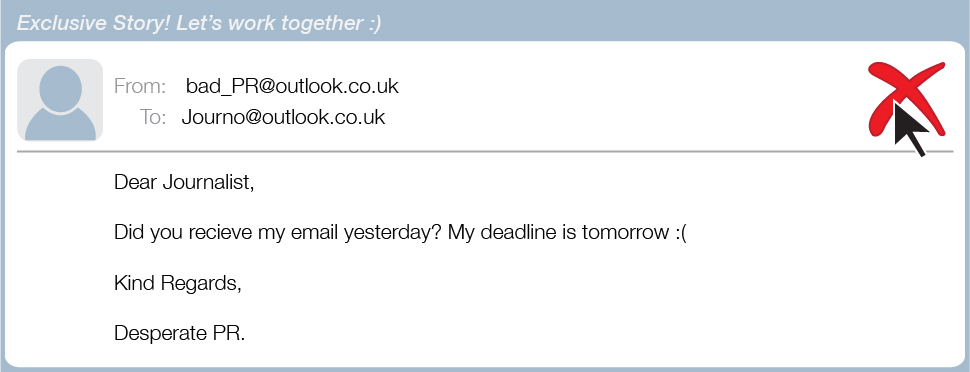
- 22 Sep 2015
- 7 Min read
Journalists and PRs: How to build bridges and learn from those you burn
- by Jade Denby
There is a gulf between PRs and journalists. If we’re cats then they’re definitely dogs, and it seems as though it’s been that way forever. But where does this animosity come from? You’d think that two groups of people with so much in common would get on famously. The root of this friction is complex, but every PR professional needs to understand and overcome these frustrations if they hope to get their clients the exposure they need. We can break it into two sections: the journalist’s beef and the PR pro’s beef.
The journalist’s beef
Journalists’ beef is that they are immensely busy and they hate having their time wasted. Journalists have one of the most stressful jobs in the world. They work inan industry with tight deadlines, with the demands of multi-platformed publications, with internet, print, e-readers and sometimes even TV all jostling for attention. And because they have all of this work coming at them from all angles, an inbox full of countless unsolicited, PR outreach emails only ruffles journalists’ feathers more.
It has become a bit of a joke for journalists to share stories of bad PR pitches they’ve received: pitches where the PR has gotten their names wrong or called them Sir instead of Madam or Ms instead of Mr. They laugh at PRs when they get the name of their publication wrong, or when the email reads like a robot has written it and is clearly a template sent out to list of a hundred journalists in one fell swoop. The most peeved journalists are now venting their frustrations via Twitter and PRs everywhere should sit up start taking note.
PR professional’s beef
The PR professional has a stressful job too, as we always want the best publications to feature and discuss our clients, yet the final say as to whether or not this happens is in the hands of a journalist, not us. It can be a very frustrating job. Our beef is more with the job itself than with journalists, but to others it probably seems as though we’re mad at them. Though we do not like it when journalists ignore us, fob us off, or are rude to us (although some of us, the bad ones, perhaps deserve it). We are sometimes frustrated that we’ve written what we perceive to be the perfect email, only to never receive a reply from the journalist. We complain to our peers when a journalist gets back to us and says they’re interested in our pitch, but then stops replying to our emails. Meanwhile, our client is asking for a progress update.
We’re the guys in the middle who must appease our clients as well as engaging correctly and sensitively with journalists. There are days when we despair about how journalists treat us, but many of us have more than earned this treatment. Many good PRs have a decent idea of what it’s like to be a journalist — many even have journalism degrees or have been a journalist at one point or another (this article is about a PR pro struggling because she used to be a journalist). But for every PR pro who gets it right, it seems like there are fifty other mavericks out there who don’t, and they damage our reputation beyond repair with every spammy template email they group-send to a journalist’s inbox. This problem has been compounded by the many SEO companies who have latched onto PR as a way to obtain links. PR is a very different beast and we must try to understand the beast if we are to have any chance of success.
How to address the PR-journalist problem
The main way to address this problem is to stop annoying journalists! But it’s not as simple as it sounds. We also have to get past their angry, PR-bashing barriers. There are different ways for different journalists, but the best advice is to actually learn a few things about the journalist you’re pitching to. Take a little time to read a few of their articles and find out what they’re about. Don’t pitch to them straight away. Instead, introduce yourself, tell them that you’ve read their work and that you’d like to send some pitches to them, sometimes, but only when you think they’ll be absolutely appropriate to them. Tell them that you know they get so much fodder in their inboxes each day, and that you don’t want to add to it, but that you want to work with them.
This approach is by no means easy, and you will have to put in a lot of legwork. And plenty of journos will still fob you off, treating you like the other, clumsy, thoughtless PRs out there. But you must persevere. Making relationships with journalists is the most effective long-term strategy, even if it feels like it’s taking too long to build up the right contacts. And if you find yourself in doubt, just remind yourself that journalists do sometimes need PRs—otherwise they wouldn’t use PR tools such as Gorkana and Response Source to solicit help from PRs, and they wouldn’t use Twitter’s PR request hashtags, such as #journorequest and #HARO. Journos just want help on their own terms, and for you to stop slinging irrelevant emails into their inboxes every day or two.
Quality PR, not quantity
At Glass Digital, we have a strong emphasis on visibility when it comes to how we interact with clients. But this also extends to journalists, webmasters and just about everyone we work with. So when you can’t (and won’t) pull the wool over anyone’s eyes, managing a client’s expectations is key. Sure, we tell new clients about the success we’ve had in the past with other clients: about how we’ve managed to get clients mentioned in the Guardian, the Mirror and the Daily Mail. But we also tell them that these placements were a long time in the making and that they took a lot of leg work. We tell them that quality editorial mentions and links (as we always have an SEO conscience with our PR) take months to attain and that we ensure that we have something interesting and pertinent to say. Gone are the days when sending the most emails or making the most phone calls guaranteed success. Although we’re not sure it ever worked at all.
Invest time in PR training
At Glass Digital we invest in PR training on the go, as our team work through our ever-growing client base. Our directors give presentations and source slides and webinars from experienced, influential people (The Guardian’s Janet Murray is a great place to start). The game is changing as digital PR is growing, as is its affiliation with the wider digital marketing industry. Any aspiring PR professional must never stop honing their craft.
Establish a set of PR outreach ethics for your PR team
Setting out clear guidelines and reiterating them often lets you maintain the right PR practises at all times. This is vital when you think of each annoyed journalist as a burnt bridge for your agency and your clients. Here at Glass Digital we have a very clear set of PR ethics that we all live by:
- No email templates. Ever!
- Personalise and research each individual journalist before you make contact. But if you don’t know them, get to the point. Overdoing the niceties can be just as annoying to a journalist who doesn’t know you as sending them a generic template.
- Do your homework. Understand the publication’s audience/demographic and what stories they read the most.
- Don’t pitch same idea to multiple journalists.
- Don’t call or email to ask if your press release was received.
- Don’t suggest that your client can write the feature: writing articles is what journalists do, after all.
- Never ask to approve the story ahead of publication!
- Always give a journalist enough lead time. Pitch weeks, perhaps even months, in advance.
- If after all this you receive a sharp reply from an aggravated journalist, politely thank them for their time and learn from the experience.
If you have a question about PR, or would like to know what Glass Digital could do for your business, then please get in touch. We’re a friendly bunch, you know!








